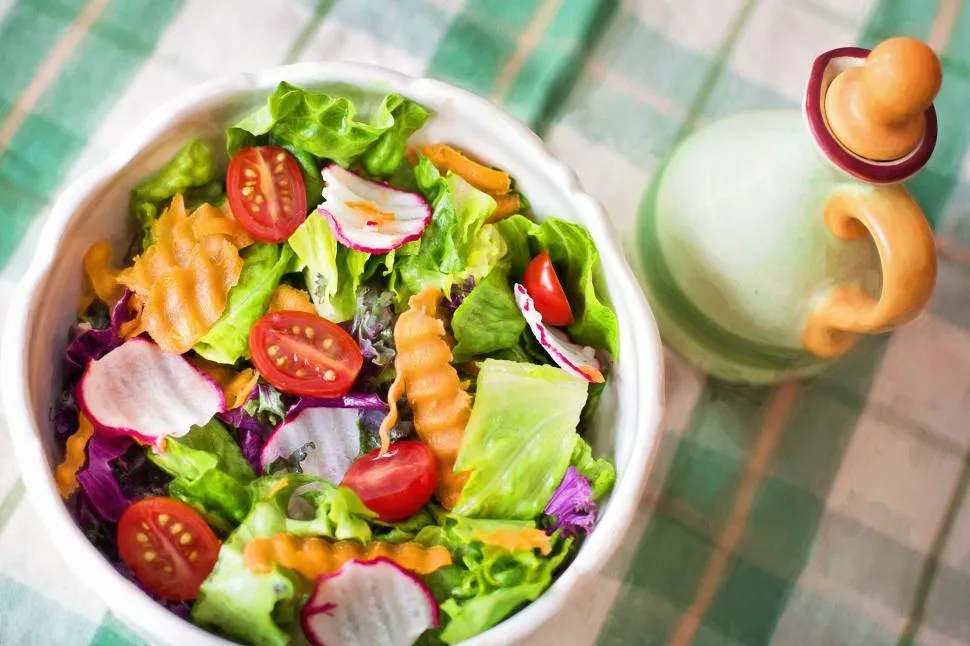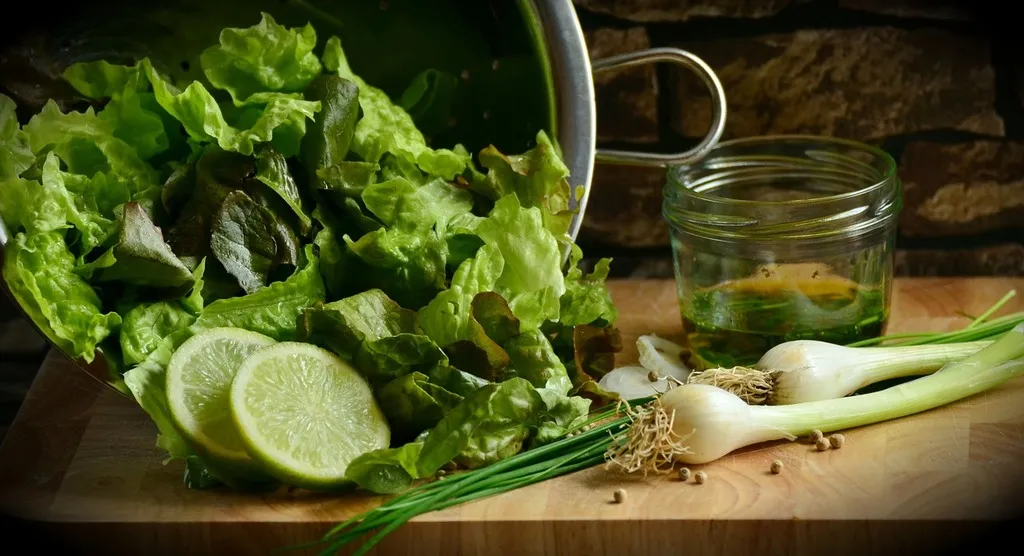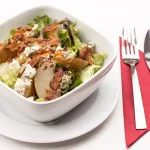The Best Fluffy Pancakes recipe you will fall in love with. Full of tips and tricks to help you make the best pancakes.
Green salads are more than a healthy side dish—they’re vibrant, customizable meals that suit any taste or diet. Whether for lunch, dinner, or a snack, a well-crafted green salad is always a great choice. Packed with leafy greens, crisp vegetables, and endless dressing and topping options, they are as versatile as they are delicious.
In this guide, we’ll explore ingredients for the perfect green salad, ways to elevate it with dressings, and toppings for flavor, texture, and nutrition. Whether you’re new to salads or a seasoned pro, you’ll find plenty of inspiration to create satisfying, exciting salads. Ready to dive in? Let’s get started!
The Best Green Salad Ingredients to Use
A green salad can be as simple or as complex as you like, but the key to making it truly delicious lies in choosing the right ingredients. From fresh, leafy greens to crunchy vegetables, protein-packed add-ins, and flavorful toppings, every element contributes to the overall taste and texture of your salad. Here’s a breakdown of the best ingredients you can use to create the perfect green salad:

1. Leafy Greens That Pack a Punch
The base of any green salad starts with leafy greens. Not only do they provide a vibrant pop of color, but they also offer essential vitamins, minerals, and fiber. Here are some of the best greens to consider:
- Spinach: A mild, tender green that’s rich in iron, fiber, and antioxidants. It’s perfect for a lighter, more delicate salad.
- Arugula: Known for its peppery flavor, arugula adds a unique, bold taste to your salad. It’s often used in Mediterranean-style salads.
- Kale: One of the most nutrient-dense greens, kale is packed with vitamins A, C, and K, as well as calcium. It has a hearty texture, making it ideal for heartier salads.
- Romaine Lettuce: Crisp and refreshing, romaine offers a satisfying crunch and a slightly sweet flavor. It’s a classic choice for Caesar salads.
- Mixed Greens: A blend of different lettuce varieties and baby greens provides a variety of textures and flavors. Look for blends that include baby kale, mizuna, or chard for added nutrition and diversity.
By combining different types of greens, you can add both variety and balance to your salad, ensuring it’s both flavorful and full of nutrients.
2. Adding Fresh Vegetables for Crunch and Flavor
To build a salad that’s not only healthy but also satisfying, you’ll want to add some crunchy, fresh vegetables. These vegetables not only contribute texture but also enhance the overall flavor profile of your salad:
- Cucumbers: Known for their refreshing crunch and mild flavor, cucumbers are a salad staple. Their high water content also makes them hydrating, which is a great bonus.
- Cherry Tomatoes: Sweet, juicy, and packed with antioxidants, cherry tomatoes provide a burst of flavor and color. They pair well with almost any type of green.
- Red Onion: Thinly sliced red onions add a sharp, tangy bite that cuts through the richness of dressings and cheese. For a milder flavor, soak them in water for a few minutes to reduce their intensity.
- Bell Peppers: Crunchy, colorful bell peppers—whether red, yellow, or orange—are rich in vitamins A and C. Their sweet, juicy flavor balances out the earthiness of greens.
- Carrots: Shredded or sliced thinly, carrots add a natural sweetness and extra crunch. Plus, they’re a great source of beta-carotene, which supports vision and skin health.
- Beets: Roasted or raw, beets offer a rich, earthy flavor. They also provide a beautiful pop of color and are high in fiber, folate, and antioxidants.
Choose a variety of colorful vegetables with different textures for a visually appealing, nutrient-packed salad.
3. Protein-Packed Additions to Make Your Salad a Meal
If you’re looking to turn your salad into a more filling meal, adding a protein source is key. Protein helps keep you full longer and adds to the overall nutritional value of your salad:
- Grilled Chicken: A lean protein that adds flavor and substance to your salad, grilled chicken pairs beautifully with almost any vegetable or dressing. For variety, try using shredded or chopped rotisserie chicken.
- Tofu: A versatile, plant-based protein, tofu absorbs the flavors of the dressing and spices you add. It’s perfect for vegetarian or vegan salads and works well when grilled or baked.
- Hard-Boiled Eggs: Packed with protein and healthy fats, hard-boiled eggs are a great addition to any salad. They also add a creamy texture that complements the crunchy vegetables.
- Quinoa: This whole grain is not only a source of protein but also a great way to add texture and substance to your salad. It’s also gluten-free, making it suitable for a variety of diets.
- Chickpeas: Whether roasted for extra crunch or tossed in as-is, chickpeas are a fiber-rich legume that provides plant-based protein. They pair wonderfully with Mediterranean-inspired salads.
Adding a protein to your salad turns it from a side dish into a complete meal, ensuring it’s satisfying and filling.
4. Nuts, Seeds, and Cheese for Extra Texture and Taste
Toppings are where you can get creative with your green salad. Nuts, seeds, and cheese not only enhance the texture but also provide rich flavors and healthy fats that make your salad even more enjoyable:
- Nuts: Almonds, walnuts, and pecans are great additions to green salads, offering a satisfying crunch and a nutty flavor. They’re also packed with healthy fats, fiber, and protein.
- Seeds: Sunflower seeds, chia seeds, and pumpkin seeds are nutrient-dense toppings that provide crunch and a dose of omega-3 fatty acids. They’re perfect for sprinkling on top of your salad.
- Cheese: A bit of cheese can elevate your salad, adding creaminess and richness. Feta, goat cheese, and Parmesan are popular choices, but you can also use blue cheese or cheddar for more robust flavors. For a dairy-free option, consider nutritional yeast, which gives a cheesy flavor without the dairy.
These toppings not only add texture but also boost the flavor of your salad. Play around with combinations to find your favorites!
For an essential tool that makes your salad prep even easier, consider the Ninja K32003 NeverDull 3-Piece Stainless Steel Knife Set, a reliable and high-quality knife set perfect for chopping, slicing, and prepping your salad ingredients. It’s designed to provide precision and ease, ensuring that you can make the perfect salad every time.
Salad Dressings to Elevate Your Green Salad
A salad can be delicious on its own with fresh, crunchy vegetables and protein-packed ingredients. But the true magic happens when you add the right dressing. Salad dressings are the key to tying together the flavors and enhancing the overall taste of your green salad. Whether you prefer something light and tangy or rich and creamy, there’s a dressing for every salad. Here are some of the best types of dressings to elevate your green salad:
1. Classic and Simple Dressings
Sometimes, simplicity is the best choice. Classic dressings offer a timeless flavor that complements the freshness of the ingredients without overpowering them. These dressings are quick to make, versatile, and can be used with a variety of salad ingredients.
- Balsamic Vinaigrette:
This classic dressing is a staple for a reason. The combination of balsamic vinegar and olive oil creates a perfect balance of tanginess and richness. A touch of Dijon mustard or honey can add a hint of sweetness, while garlic or shallots provide depth. It pairs wonderfully with greens like arugula, spinach, and mixed greens, making it a go-to option for almost any salad. - Olive Oil and Lemon Dressing:
For a fresh, light dressing, olive oil and lemon juice are an unbeatable combination. The olive oil provides richness, while the lemon juice adds a citrusy zing that brightens up your salad. A pinch of salt, pepper, and herbs like oregano or thyme can turn this simple dressing into a flavorful addition to Mediterranean-style salads. - Caesar Dressing:
Caesar dressing is a creamy, tangy classic that transforms a simple romaine lettuce salad into a rich and savory dish. Made with anchovies, garlic, Parmesan, and a touch of lemon juice, this dressing is both bold and satisfying. While traditionally used in Caesar salads, it also works beautifully on green salads with grilled chicken or bacon for an extra indulgent treat.
Pro Tip: Customize dressings with honey, mustard, or vinegars (like apple cider or red wine) to match your taste.
2. Creamy and Rich Dressings
Creamy dressings bring a rich, indulgent element to any salad. While they add a satisfying texture and flavor, you can easily lighten them up by using healthier ingredients without sacrificing taste. These dressings are perfect for those who love a little more substance and comfort in their salads.
- Ranch Dressing:
A crowd favorite, ranch dressing offers a creamy, herby flavor that complements almost any salad. Made with sour cream or Greek yogurt, garlic, and fresh herbs like parsley and dill, ranch is perfect for simple salads or those with added veggies and protein. For a lighter version, swap out the mayo or sour cream for Greek yogurt for an extra boost of protein and creaminess. - Greek Yogurt-Based Dressing:
If you love creamy dressings but want a healthier alternative, Greek yogurt-based dressings are the way to go. Greek yogurt provides a rich, creamy base that’s lower in calories and higher in protein than traditional creamy dressings. Add lemon juice, olive oil, garlic, and herbs like dill or mint for a refreshing, tangy dressing that pairs especially well with Mediterranean-inspired salads or a simple cucumber and tomato salad. - Honey Mustard Dressing:
Sweet and tangy, honey mustard dressing is another rich option that brings both sweetness and a bit of heat. The combination of honey, mustard, vinegar, and olive oil creates a balance of flavors that works beautifully with roasted vegetables, grilled chicken, or leafy greens. For a lighter version, use a reduced-fat mustard or yogurt to replace some of the oil or honey.
Pro Tip: To make creamy dressings even healthier, consider using avocado as the base. It provides a smooth, rich texture and healthy fats, making for a naturally creamy dressing.
3. Flavorful and Exotic Dressings
For salad lovers looking to try something new and exciting, these flavorful and exotic dressings bring a fresh twist to your green salad. These dressings often have bold and complex flavors, perfect for adventurous eaters who want to mix up their salad game.
- Tahini Dressing:
Tahini, made from ground sesame seeds, is a great base for creamy, nutty dressings. Mixed with lemon juice, garlic, and a little olive oil, tahini dressing provides a savory richness that pairs wonderfully with Middle Eastern salads like tabbouleh or Mediterranean-inspired bowls. It’s also a great option for vegan salads, adding a healthy dose of calcium and healthy fats. - Poppy Seed Dressing:
For a sweet and tangy dressing that works well with fruits and greens, poppy seed dressing is an excellent choice. Made with white wine vinegar, honey, mustard, and poppy seeds, this dressing adds both flavor and texture. It’s perfect for fruit-heavy salads (think strawberries, oranges, and apples) or those with nuts and cheese, like spinach and walnut salads. - Avocado-Based Dressing:
Creamy and vibrant, avocado-based dressings add a burst of freshness to your salad while also offering healthy fats. Simply blend ripe avocado with lime juice, olive oil, and herbs, and you’ll have a dressing that’s both creamy and tangy. It works beautifully with greens like kale and romaine, as well as hearty additions like grilled shrimp or chicken. - Chimichurri Dressing:
A popular Argentine sauce, chimichurri is a vibrant, herbaceous dressing made with parsley, garlic, vinegar, and olive oil. Its bold, fresh flavor adds a punch to your salad and pairs well with grilled meats, roasted vegetables, or even a simple green salad with avocado.
Pro Tip: To make any of these dressings even more unique, try adding a spicy element like chili flakes or sriracha for an extra layer of flavor.
Making Dressings at Home vs. Store-Bought
While store-bought dressings can be convenient, making your own salad dressings at home allows you to control the ingredients and customize the flavor. Homemade dressings are often healthier, with fewer preservatives and added sugars. Plus, they’re incredibly easy to make! You only need a few basic ingredients like olive oil, vinegar, mustard, and fresh herbs to create a dressing that rivals anything you can buy at the store.
Pro Tip: If you’re short on time, making your dressing in a mason jar is the easiest way to shake up the ingredients and create an emulsified dressing in just a few seconds.
Toppings That Will Transform Your Green Salad
While the base of your green salad—made from fresh greens, vegetables, and proteins—forms the heart of the dish, it’s the toppings that truly transform a simple salad into something special. The right toppings add texture, flavor, and even nutritional benefits, making every bite a satisfying experience. Whether you’re looking for a crunchy contrast, a sweet touch, or something savory, here’s a guide to the best toppings to elevate your salad:

1. Crunchy Toppings for Texture and Bite
Texture is just as important as flavor when it comes to creating a balanced salad. Adding crunchy toppings introduces an exciting contrast to the tender greens, making each bite more enjoyable. These ingredients provide that satisfying crunch that makes a salad feel hearty and substantial.
- Croutons:
Made from toasted bread and often seasoned with garlic and herbs, croutons add an irresistible crunch to any salad. Whether you make them at home or buy them pre-made, croutons offer a warm, comforting texture that works well with creamy dressings like Caesar or ranch. For a healthier alternative, you can use whole-grain or gluten-free bread, or even air-fry your croutons for a lower-fat version. - Nuts:
Nuts not only add crunch but also provide healthy fats, protein, and a satisfying richness to your salad. Almonds, walnuts, pecans, and cashews are popular choices that pair well with almost any salad. You can use them whole, chopped, or even toasted for an extra layer of flavor. Try toasted pecans with spinach and goat cheese for a deliciously nutty twist, or sprinkle some chopped almonds on a kale and apple salad for a crunchy contrast. - Seeds:
Seeds like sunflower seeds, pumpkin seeds (pepitas), and chia seeds are another great way to add texture to your salad. They’re packed with fiber, healthy fats, and antioxidants, making them a nutrient-dense addition. Sunflower seeds, in particular, are mild in flavor, allowing them to complement a variety of salad types, from mixed greens to grain-based salads. Pumpkin seeds add a slightly nutty, earthy flavor that pairs perfectly with squash or roasted vegetables. - Tortilla Chips or Pita Chips:
For a unique crunch, consider adding broken tortilla chips or pita chips to your salad. These crispy pieces bring a satisfying texture that pairs well with southwestern-style salads or taco salads. You can even season them with chili powder or lime zest for an extra burst of flavor.
2. Sweet Additions for Contrast and Flavor Balance
A touch of sweetness can elevate your salad, balancing out savory and tangy flavors for a more complex taste experience. These sweet toppings add an exciting burst of flavor that can transform an ordinary salad into something extraordinary.
Fresh Fruit
Fruits like berries, citrus, and tropical options brighten up the salad with juicy sweetness. Strawberries, blueberries, and mangoes create a delightful contrast to savory greens, while citrus fruits like oranges add both sweetness and a touch of acidity.
Dried Fruit
Cranberries, raisins, and apricots offer a chewy sweetness that pairs wonderfully with leafy greens and roasted vegetables. Dried cranberries, with their tart-sweet balance, complement nuts and creamy cheeses like goat or blue cheese.
Fresh Apple or Pear Slices
Thinly sliced apples or pears add a refreshing crunch and natural sweetness. Tart apples like Granny Smith balance out creamy dressings, while pears provide a soft, juicy contrast.
Honey or Agave Drizzle
A drizzle of honey or agave syrup adds just the right touch of sweetness, especially on bitter greens like arugula. These natural sweeteners complement berries, nuts, and creamy cheeses for a well-rounded salad.
3. Savory and Cheesy Additions for Richness
Cheese can bring a whole new level of richness and flavor to your salad. From creamy goat cheese to sharp Parmesan, cheese adds depth and complexity to any salad, making it feel like a more substantial dish.
- Cheese Crumbles:
Whether it’s crumbled feta, goat cheese, or blue cheese, adding cheese to your salad infuses it with creamy, tangy flavor. Feta and goat cheese are especially popular for Mediterranean-inspired salads, while blue cheese adds a bold, sharp bite to arugula or spinach-based salads. If you prefer a milder flavor, Parmesan shavings or grated Pecorino Romano can add a touch of saltiness and complexity. - Shredded Cheese:
Shredded varieties like cheddar, mozzarella, or a mix of Italian cheeses are great for topping your salad. Shredded cheese melts slightly over warm salad ingredients (like grilled chicken or roasted vegetables), adding a creamy texture that complements the crunch of fresh greens. For a more gourmet touch, try using Gruyère or aged Gouda. - Bacon or Prosciutto:
Crispy bacon bits or thin slices of prosciutto provide a savory, salty contrast to the fresh and slightly sweet elements of your salad. Bacon brings a smoky richness that pairs well with sweet fruits, while prosciutto adds a delicate, slightly salty flavor that enhances Mediterranean-style salads. For a lighter, healthier option, turkey bacon or prosciutto alternatives can be used. - Olives:
Olives bring a briny, savory depth to any salad, especially those with Mediterranean influences. Kalamata olives are popular for their bold, tangy flavor, while green olives offer a milder brininess. Whether you use them whole, pitted, or sliced, olives add a satisfying complexity to your salad, complementing flavors like feta, tomatoes, and cucumbers.
4. Herbs and Spices for Extra Flavor and Freshness
Fresh herbs and spices are a simple way to add layers of flavor without overwhelming the dish. A sprinkle of the right herb or spice can make a salad taste like it came straight from a fine-dining restaurant.
- Fresh Herbs:
Fresh herbs like basil, cilantro, parsley, dill, or mint can infuse your salad with a burst of aromatic freshness. For instance, fresh basil pairs beautifully with tomatoes and mozzarella, while cilantro adds a zesty kick to Southwest or taco salads. Chopped mint can also be a refreshing addition to fruit-heavy salads or Mediterranean dishes. - Spices:
A pinch of ground black pepper, cumin, or chili flakes can add a touch of warmth and spice to your salad. Ground cumin is especially good with Middle Eastern-inspired salads, while chili flakes bring heat to Mexican or Southwest-style salads. A touch of smoked paprika can add a subtle, smoky flavor that pairs well with grilled meats or roasted vegetables. - Microgreens:
Microgreens are tiny, tender young plants like radish greens, pea shoots, or mustard greens that pack a punch of flavor. Their delicate texture and peppery, earthy taste elevate the flavor profile of your salad, making them a perfect topping to add a sophisticated touch.
Salad Variations for Every Taste and Diet
One of the great things about salads is their versatility. No matter your dietary preferences, lifestyle choices, or taste buds, there’s a salad variation to suit every need. Whether you’re a meat eater, vegetarian, vegan, or following a low-carb or gluten-free diet, you can enjoy a delicious, nutritious salad that aligns with your goals. Below are some of the most popular salad variations tailored to various tastes and dietary needs.

1. Classic Green Salad for All Ages
A classic green salad is a great go-to for any meal, offering a balance of flavors and textures. It’s incredibly adaptable and can be tailored to your preferences by adjusting the ingredients, dressings, and toppings.
- Base Ingredients: Romaine lettuce, iceberg lettuce, spinach, arugula, mixed greens, or a combination of these greens are the foundation of a classic salad. Add fresh vegetables like cucumbers, tomatoes, bell peppers, red onions, and carrots for color and crunch.
- Protein Additions: For a more substantial meal, top with grilled chicken, boiled eggs, or even bacon bits. You can also add cheese for a creamy touch, such as shredded cheddar, mozzarella, or crumbled feta.
- Dressings: A simple balsamic vinaigrette, classic ranch, or Italian dressing is all you need to bring these fresh ingredients together into a classic salad that everyone will love.
Classic green salads are perfect for picnics, barbecues, or as a side to any meal.
2. Mediterranean Salad for Freshness and Flavor
If you’re craving something fresh with bold Mediterranean flavors, this variation is perfect for you. Mediterranean salads are typically vibrant, with a combination of fresh vegetables, olives, feta cheese, and tangy dressing. They are rich in healthy fats from olive oil and nutrient-dense vegetables.
- Base Ingredients: Romaine lettuce or mixed greens serve as the base for this salad. Add cucumbers, cherry tomatoes, red onions, and bell peppers.
- Flavorful Additions: Kalamata olives, feta cheese, and chickpeas (or other beans) add protein and richness. Fresh herbs like parsley, oregano, and mint bring aromatic flavors to the salad.
- Dressings: A simple lemon and olive oil dressing with a touch of garlic, salt, and pepper perfectly complements the fresh vegetables and creamy feta cheese. You can also use a store-bought Greek dressing if you want a shortcut.
This salad is not only fresh but also filling, making it ideal for a light lunch or dinner, especially when paired with grilled meats like lamb, chicken, or fish.
3. Vegan Salad for Plant-Based Diets
For those following a vegan lifestyle, a plant-based salad packed with vegetables, legumes, and healthy fats can be incredibly satisfying. Vegan salads are full of nutrients, antioxidants, and fiber, making them both nourishing and delicious.
- Base Ingredients: The base of a vegan salad can be made up of leafy greens like kale, spinach, or arugula. You can also mix in other greens like cabbage, collard greens, or lettuce.
- Protein Additions: Chickpeas, black beans, quinoa, tofu, tempeh, or roasted lentils serve as excellent sources of plant-based protein. These ingredients provide substance and make the salad more filling.
- Flavor Enhancers: Add fresh veggies like avocado for healthy fats, or roasted sweet potatoes and beets for extra texture and flavor. Sliced almonds or sunflower seeds can bring a satisfying crunch.
- Dressings: A creamy tahini dressing, vegan dressing, balsamic vinegar and olive oil, or a lemon and mustard vinaigrette will elevate the flavors of the salad without dairy or animal products.
This variation is perfect for lunch or dinner and can be made in bulk for meal prepping throughout the week.
4. Low-Carb Keto Salad for a Healthy, Low-Carb Lifestyle
For those following a keto or low-carb diet, salads can be a great way to get in plenty of vegetables while keeping your carb count low. Keto salads are designed to be rich in healthy fats and protein while minimizing carbohydrates.
- Base Ingredients: Leafy greens like spinach, kale, and arugula are ideal for a keto salad because they are low in carbs and high in nutrients. Avocado is a great addition, providing both creaminess and healthy fats.
- Protein Additions: Chicken, turkey, bacon, and boiled eggs are great sources of protein for a keto-friendly salad. For more variety, you can add grilled salmon or shrimp.
- Flavor Boosters: For extra flavor, include cheese like cheddar, blue cheese, or goat cheese. Olives and cucumbers add a satisfying crunch with minimal carbs. You can also use nuts like almonds or walnuts to enhance the texture and nutritional value.
- Dressings: Stick with a high-fat, low-carb dressing like ranch, blue cheese, or Caesar dressing. Alternatively, you can make your own with olive oil, mustard, and vinegar for a quick and simple option.
Keto salads can be a satisfying meal or a great side to complement a main dish while keeping your carb intake in check.
5. Gluten-Free Salad for Sensitive Diets
For individuals with gluten sensitivity or celiac disease, it’s essential to choose ingredients that are naturally gluten-free. Fortunately, many salad ingredients are gluten-free by nature, making it easy to create delicious and safe options for those avoiding gluten.
- Base Ingredients: Fresh greens like romaine lettuce, arugula, or mixed greens form the base of any gluten-free salad. Include a variety of colorful veggies such as carrots, tomatoes, cucumbers, and radishes.
- Protein Options: Grilled chicken, beef, or shrimp are all naturally gluten-free and great additions to salads. If you prefer plant-based proteins, chickpeas, quinoa, or roasted tofu are perfect gluten-free alternatives.
- Flavorful Additions: Add cheese like feta, mozzarella, or goat cheese for a creamy texture, along with gluten-free nuts like almonds or pecans for extra crunch.
- Dressings: Most homemade dressings—such as olive oil, lemon, and vinegar-based dressings—are gluten-free. Just be sure to avoid store-bought dressings that may contain gluten or added thickeners.
This variation is ideal for anyone with gluten sensitivities but still wants to enjoy a fresh, flavorful salad.
6. Protein-Packed Salad for Fitness Enthusiasts
For those looking to refuel after a workout or simply maintain a healthy lifestyle, a protein-packed salad is the way to go. These salads are high in protein, which helps with muscle recovery and keeps you feeling full longer.
- Base Ingredients: Leafy greens like kale, spinach, or arugula are great options. Add in crunchy vegetables like cucumbers and carrots to provide a variety of textures.
- Protein Additions: Grilled chicken, turkey breast, lean steak, or salmon are excellent sources of protein. If you’re vegetarian, tofu, tempeh, and quinoa are protein-rich plant-based alternatives.
- Flavor Boosters: Adding hard-boiled eggs, nuts, seeds, or cheese like feta or mozzarella will not only contribute protein but also enhance the overall flavor of the salad.
- Dressings: Opt for a protein-boosting dressing such as a yogurt-based dressing or one made with Greek yogurt to add even more protein to your meal. Olive oil and balsamic vinegar are also simple and effective dressings for a protein-packed salad.
Protein-packed salads are perfect for post-workout meals or as a hearty lunch to power through your day.






[…] a delicious homemade version of this iconic sandwich. And for a perfect pairing, check out our Ultimate Guide to Green Salads: Variations, Dressings, and Toppings for the ideal side dish to complement your […]
Spot on with this write-up, I really believe this site
needs much more attention. I’ll probably be returning to read through
more, thanks for the information!
Right away I am going to do my breakfast, when having my breakfast
coming again to read other news.
[…] it with creamy mashed potatoes and roasted broccoli. If you want something lighter, try a crisp garden salad or steamed green beans. For comfort food lovers, pair it with buttered pasta or garlic bread for […]